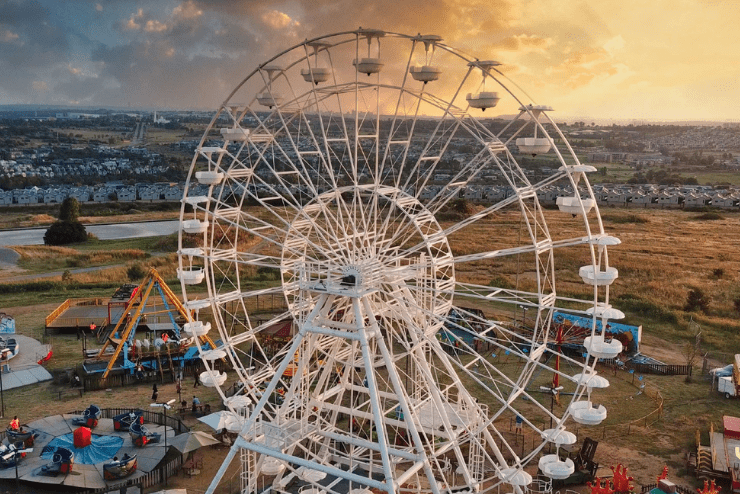The Single Strategy To Use For Johannesburg North Attractions
The Single Strategy To Use For Johannesburg North Attractions
Blog Article
4 Simple Techniques For Johannesburg North Attractions
Table of Contents6 Easy Facts About Johannesburg North Attractions ShownJohannesburg North Attractions for DummiesAll About Johannesburg North AttractionsThe Of Johannesburg North AttractionsWhat Does Johannesburg North Attractions Mean?The 10-Second Trick For Johannesburg North Attractions
The city expanded on the side of the Witwatersrand Key Coral reef, a below ground stratum of gold-bearing quartz-silica corporation that arcs for hundreds of miles under the Highveld - Johannesburg North attractions. Many of the gold mines in the city ceased operation in the 1970s, however in its day the Witwatersrand gold industry accounted for even more than 40 percent of the globe's yearly gold production.Johannesburg has a pleasant climate. The city enjoys about 8 hours of sunlight per day in both wintertime and summer season.
What rainfall the city gets falls practically exclusively in the summer season, commonly in amazing late-afternoon electrical tornados. Air pollution postures a considerable problem, especially in the winter season months, when thermal inversions hamper the westward circulation of air from the Indian Ocean. Pollution is most serious in the densely settled Black towns on the city's perimeter, where lots of homeowners still depend on coal for gas.

Johannesburg North Attractions Things To Know Before You Get This
The equilibrium of the city is inhabited by whites. Lodging differs in character and high quality.
Physical growth, although rather limited by transportation, proceeded promptly as migration to South Africa, and Johannesburg particularly, increased significantly. This problem was solved in the 1930s when the automobile was introduced in mass manufacturing to South Africa. Autos were, for the many part, constrained to the well-off, and allowed them to relocate to the north of the city and commute into the centre.
A lot of inadequate suburban areas were blended, with inadequate blacks and whites cohabiting, although the well-off suburban areas were usually booked for whites. This altered with the political election of the National Celebration in the 1948 political elections, who began to formalise the system recognized as racism. Racism formally designated which residential areas each race could stay in under the Group Locations Act.
The previous system of eleven numbered areas was reorganised in 2006. Marshalltown, as seen from the top of the Carlton Centre. The M1 and M2 run behind the structures, and the southern suburban areas extend past the freeway border. The inner city of Johannesburg lies within the city's Region F. The estimated population of the area is 200,000, [] The number of individuals living in the inner city on a casual basis is unidentified, as many are illegal immigrants. Most higher-income locals and white people have moved to the north suburban areas and have actually been changed by lower-income black individuals. The unemployment, education, and age profiles of the area are all unknown, due to the difficulty of obtaining trusted details regarding the location.
The Best Guide To Johannesburg North Attractions
Centred on the CBD, the area consists of the residential areas of Yeoville, Bellevue, Troyeville, Jeppestown, and Berea to the east. To the west it spreads out to Pageview (Johannesburg North attractions) and Fordsburg. There are small commercial locations to the south, such as City West-Denver and Benrose. Around 800,000 commuters pass through the internal city everyday, and it works as a local shopping node for site visitors from the southern suburban areas. Yeoville and Bellevue have a mix of apartment buildings and single household systems on tiny lots. The area is situated on a hilly divide that runs from east to west.

The Johannesburg North Attractions Ideas
R. Tambo International Airport). The eastern residential areas are several of the oldest locations of Johannesburg, there are large neighborhoods of Jewish and other European backgrounds, the bulk of the populace is English speaking. There are three golf links along with a number of protected ridges with viewsites. There are numerous strong and up-market entertainment and shopping areas in the east such as the Eastgate Mall and the Greenstone purchasing click here to read centre.
The location is mostly composed of old "matchbox" homes, or four-room houses developed by the federal government, that were developed to provide cheap accommodation for black employees during discrimination. Soweto is an acronym, representing "South Western Townships". Street after road in this field is lined with matchboxes; nevertheless, there are a few smaller areas where thriving Sowetans have developed residences that are more check my site comparable in stature with those in even more wealthy suburban areas.
Hostels are one more popular physical attribute of Soweto. Initially constructed to house male migrant workers, many have actually been boosted as dwellings for couples and households. The N1 Western Bypass skirts the eastern limit of Soweto. The suburban area was not traditionally permitted to develop employment centres within the area, so nearly all of its citizens are travelers to various other components of the city.
The Definitive Guide to Johannesburg North Attractions
The residential locations in the northern suburbs are primarily official, with no considerable areas of informal housing, or real estate that lacks a long-term structure. This is a well-known area, there is a pattern of land use modification from residential to industrial, particularly along main arterial roads and around recognized nodes.
The location is well attached to roadway networks, particularly along the north-south axis formed by the M1 and N1. Roads to the eastern and west are much less well created, as great site there are no freeways travelling in that direction. Towards the northern border of the city, the density of development reduces, leaving huge locations of undeveloped land around Midrand.
All about Johannesburg North Attractions
, which is situated on a hillside neglecting the internal city and Hillbrow.
Report this page